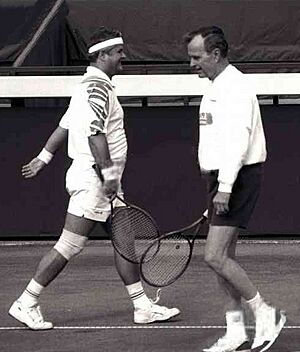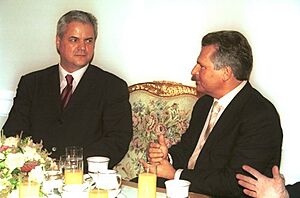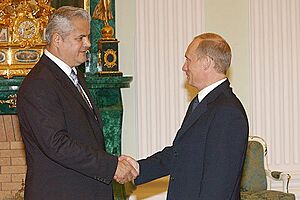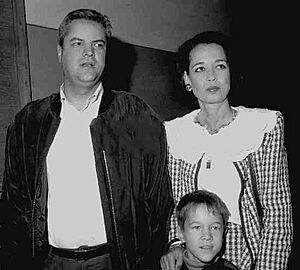Adrian Năstase facts for kids
Quick facts for kids
Adrian Năstase
|
|
|---|---|

Năstase in 2006
|
|
| Prime Minister of Romania | |
| In office 28 December 2000 – 21 December 2004 |
|
| President | Ion Iliescu |
| Preceded by | Mugur Isărescu |
| Succeeded by | Eugen Bejinariu (Acting) Călin Popescu Tăriceanu |
| President of the Chamber of Deputies | |
| In office 21 December 2004 – 15 March 2006 |
|
| President | Traian Băsescu |
| Preceded by | Valer Dorneanu |
| Succeeded by | Bogdan Olteanu |
| In office 1 March 1992 – 22 November 1996 |
|
| President | Ion Iliescu |
| Preceded by | Dan Marțian |
| Succeeded by | Ion Diaconescu |
| Minister of Foreign Affairs | |
| In office 28 June 1990 – 18 November 1992 |
|
| Prime Minister | Petre Roman Theodor Stolojan |
| Preceded by | Sergiu Celac |
| Succeeded by | Teodor Meleșcanu |
| President of the Social Democratic Party | |
| In office 20 December 2000 – 21 January 2005 |
|
| Preceded by | Ion Iliescu |
| Succeeded by | Mircea Geoană |
| Member of the Chamber of Deputies | |
| In office 18 June 1990 – 20 June 2012 |
|
| Personal details | |
| Born | 22 June 1950 Bucharest, Romanian People's Republic |
| Political party | Social Democratic Party (2001–present) |
| Other political affiliations |
Romanian Communist Party (Before 1989) National Salvation Front (1989–1992) Democratic National Salvation Front (1992–1993) Party of Social Democracy in Romania (1993–2001) |
| Spouses | Ilinca Preoteasa (Divorced) Dana Miculescu |
| Alma mater | University of Bucharest |
| Profession | Lawyer |
| Signature |  |
Adrian Năstase (born 22 June 1950) is a Romanian lawyer, professor, and former politician. He served as the Prime Minister of Romania from December 2000 to December 2004.
He ran for president in the 2004 Romanian presidential election as the candidate for the Social Democratic Party (PSD). He was defeated by Traian Băsescu.
He was also the president of the Chamber of Deputies of Romania from December 2004 until March 2006. He stepped down from this role due to legal investigations.
Many people, including his political rivals, see Năstase as a very effective Prime Minister after the communist era. He is praised for helping Romania join the European Union and NATO. He also worked to make Romania's economy stronger and more modern.
Contents
Adrian Năstase's Life Story
Early Life and Family
Adrian Năstase was born in Bucharest, the capital city of Romania. His family came from a village called Hanul de Pământ. His father, Marian Năstase, was an officer in the Royal Romanian Army. His mother's name is Elena, and he has a sister named Dana.
Education and Early Career
Adrian Năstase attended Nicolae Bălcescu High School, which is now known as Saint Sava National College. After high school, he studied at the University of Bucharest. He earned degrees in both Law and Sociology. Before becoming a politician, he worked as a professor and a judge. He also led several organizations focused on law and international relations.
On 31 July 1985, he married Dana Miculescu. They have two sons: Andrei, born in 1986, and Mihnea, born in 1993.
Political Journey After 1989

Năstase first became a member of the Chamber of Deputies of Romania on 9 June 1990. He was part of the National Salvation Front party. From June 1990 to October 1992, he served as the Minister of Foreign Affairs. He worked under Prime Ministers Petre Roman and Theodor Stolojan.
In 1992, he was re-elected to the Chamber of Deputies. This time, he was a member of the Democratic National Salvation Front (FDSN). He then became the president of the Chamber of Deputies. From 1993 to 1997, he was also a leader of the Party of Social Democracy in Romania (PDSR), which was formerly the FDSN.
After the 1996 elections, his party, the PDSR, did not win. Năstase became the leader of the opposition group in Parliament. He also served as a vice-president of the Chamber of Deputies. He was part of Romania's team at the Parliamentary Assembly of the Council of Europe.
In 2000, the PDSR won the legislative elections. Ion Iliescu was re-elected as president. Năstase was then chosen as the president of the PDSR. The party later changed its name to the Social Democratic Party (PSD). Năstase remained the PSD president until April 2005. He was then replaced by Mircea Geoană. At the same time, Năstase was elected as the PSD executive president, which is the second most important role in the party.
Time as Prime Minister of Romania

Adrian Năstase became Prime Minister on 28 December 2000. He was appointed by President Ion Iliescu and confirmed by the Parliament. He led the country for four years, while also leading the PSD.
His time as Prime Minister brought a lot of stability to Romania after the communist era. The country saw steady economic growth. His foreign policy focused strongly on building ties with Western countries. Romania joined NATO during his term. Romanian troops also helped in international efforts in the Balkans, Afghanistan, and Iraq.
His government worked hard to help Romania join the European Union (EU). They passed many laws and made reforms needed for EU membership. Romania officially joined the EU in 2007. His government also successfully removed visa restrictions on Romanians traveling to EU countries.

During his term, inflation decreased, and the Romanian currency, the Romanian leu, became stronger. The country's economy grew significantly each year. For example, in 2004, the economy grew by 8.3%, which was the highest in the region. Average wages also increased.
However, some critics noted that economic growth was not spread equally among all people. Many Romanians, especially in rural areas, still lived below the poverty line.

2004 Presidential Campaign
In 2004, President Ion Iliescu could not run for another term. The PSD chose Adrian Năstase as their candidate for president. His running mate, who would become prime minister if Năstase won, was Mircea Geoană.
Opinion polls in 2004 suggested Năstase would win the election. He had strong support in rural areas and in smaller towns in the south and east of Romania. He was also popular among older people and workers.
In the first round of the presidential elections on 28 November, Năstase was ahead. However, he did not get more than 50% of the votes. This meant he had to compete in a second round, called a run-off election, on 12 December. His opponent was Traian Băsescu, the candidate from the center-right Justice and Truth Alliance (DA).
On the night of the run-off election, exit polls showed a very close race. However, Băsescu's supporters believed he had won. Many of them gathered in University Square in Bucharest to celebrate. The next morning, the official results confirmed that Băsescu had won. Năstase received 48.77% of the total votes.
Năstase later said that his defeat was due to several reasons. These included a lack of support from some political allies and an endorsement of Băsescu by another party leader. Other factors might have been Băsescu's strong performance in debates and ongoing questions about Năstase's actions.
Even though Năstase lost the presidential election, his party, the PSD, still won the most seats in Parliament. After the elections, Năstase was elected as president of the Chamber of Deputies of Romania. He resigned as prime minister the day after Băsescu became president.
Legal Challenges and Later Life
Adrian Năstase faced legal challenges related to his time in office. In 2012, he received a prison sentence. He was the first former head of government in Romania to be sentenced to prison after the 1989 revolution. He was released in 2013. In 2014, he received another prison sentence for different reasons, but was released later that year.
In December 2021, the Romanian Supreme Court accepted Năstase's request for judicial rehabilitation. This means that if the decision becomes final, he will be able to vote and run for public office again.
In recent years, Năstase has advised officials on state affairs and international relations. He helps with solving disagreements between countries and strengthening diplomatic and economic ties.
See also
 In Spanish: Adrian Năstase para niños
In Spanish: Adrian Năstase para niños



